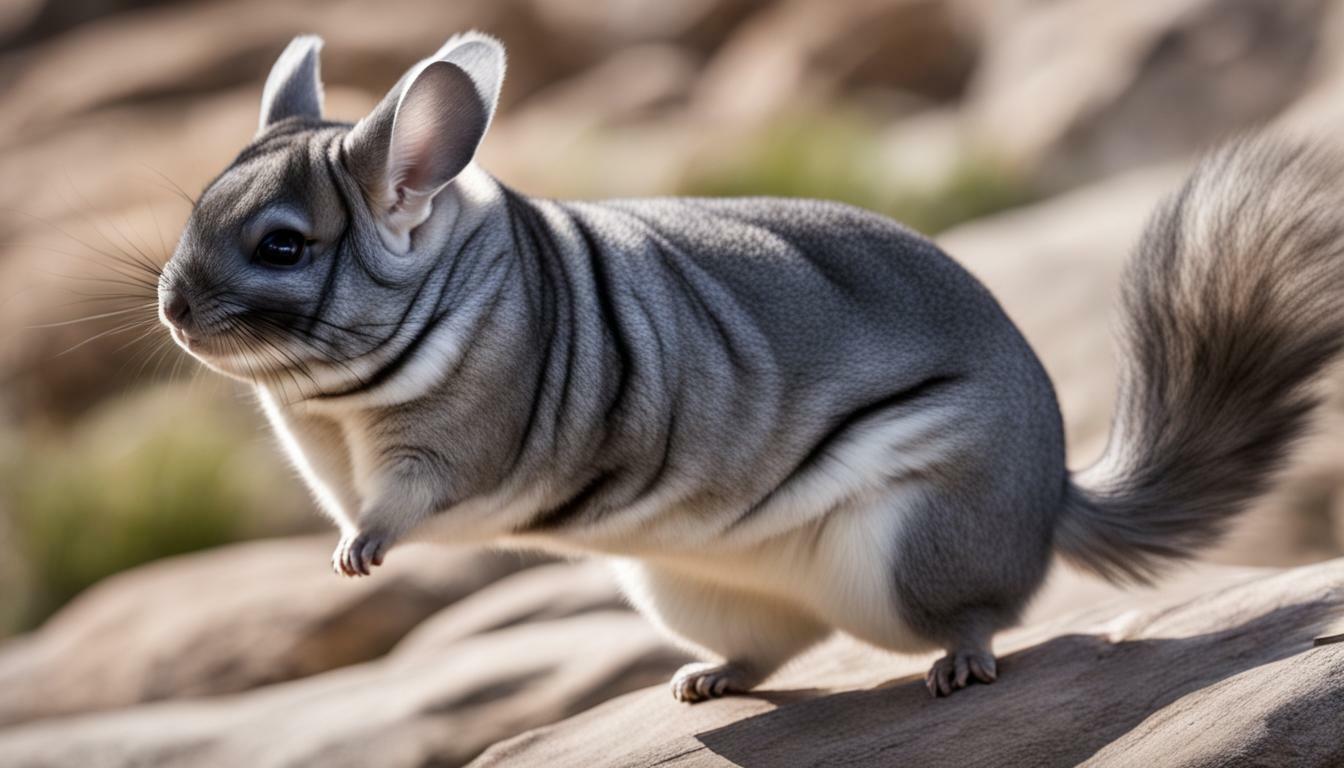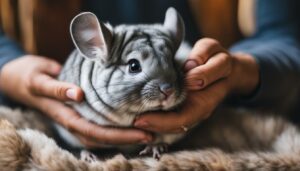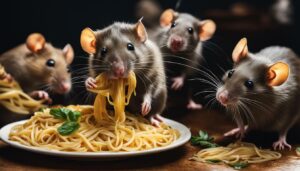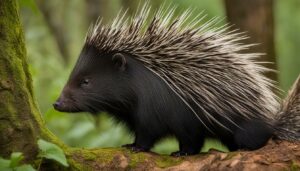Chinchillas are adorable rodents that are often associated with their impressive jumping abilities, but can they actually glide through the air like some other animals?
Chinchillas have strong hind legs that enable them to jump from the floor to the top of a refrigerator, showcasing their agility and athleticism. However, they are not capable of gliding like sugar gliders or flying squirrels.
Unlike these gliding animals, chinchillas do not possess flaps of skin or wings that would allow them to glide through the air. Their bodies are not built for aerial gliding, and they rely on their powerful legs for movement instead.
Chinchillas are known for their shy nature and are often considered better suited for older children who can handle them with care. They can live for around 10 to 20 years, making them a long-term commitment as pets.
Providing a suitable environment for chinchillas is crucial for their well-being. They require a large, tall cage with multi-level platforms, allowing them to explore and exercise. Chew toys are also essential to prevent them from chewing on furniture and other household items.
Key Takeaways:
- Chinchillas cannot glide through the air like sugar gliders or flying squirrels.
- They are known for their impressive jumping abilities, thanks to their strong hind legs.
- Chinchillas are better suited for older children due to their shy nature.
- They can live for around 10 to 20 years, making them a long-term commitment as pets.
- A suitable environment for chinchillas includes a large, tall cage with multi-level platforms and chew toys to prevent destructive behavior.
Understanding Chinchilla Anatomy
To understand why chinchillas cannot glide, it is important to take a closer look at their unique anatomy. These adorable rodents have distinct features that set them apart from gliding animals such as sugar gliders. While chinchillas have strong hind legs that allow them to perform impressive jumps, they lack the necessary adaptations for aerial gliding.
Unlike sugar gliders, which have flaps of skin called patagium between their legs that enable them to glide through the air, chinchillas do not possess such structures. Instead, their anatomy is designed for agility and speed on land. With large ears and bushy tails, chinchillas have adapted to their natural habitat in the Andes Mountains, where they navigate rocky terrain and rely on their powerful hind legs to leap from one ledge to another.
Chinchillas are often adored for their cute appearance and playful behavior, but it is important to note that they are not suitable pets for everyone. While they may seem like fascinating creatures to have around, chinchillas can be quite shy and may require a patient and understanding owner. If you’re considering getting a chinchilla as a pet, it’s crucial to understand their specific care requirements.
| Chinchilla Facts | |
|---|---|
| Lifespan: | Around 10 to 20 years |
| Recommended Cage: | Large, tall cage with multi-level platforms |
| Behavior: | Shy and may be better suited for older children |
| Environmental Enrichment: | Provide chew toys to prevent destructive behavior |
Chinchilla care involves providing them with a suitable environment that mimics their natural habitat. A spacious cage with multiple levels allows these active animals to climb and explore. Additionally, supplying them with chew toys is essential to prevent them from chewing on furniture or other household items.
In conclusion, while chinchillas may possess impressive jumping abilities, they are not capable of gliding like animals with specialized adaptations. Their unique anatomy, with strong hind legs and absence of gliding structures, reflects their natural habitat and hunting instincts. Understanding their anatomy is key to providing the proper care and environment for these adorable rodents.
Chinchilla Jumping Abilities
While chinchillas may not be able to glide, their jumping abilities are truly remarkable. These adorable rodents possess strong hind legs that allow them to propel themselves with impressive force. With a single leap, they can easily jump from the floor to the top of a refrigerator or onto high platforms in their habitat.
Chinchillas’ incredible jumping prowess is a reflection of their natural agility on land. They have evolved to navigate their surroundings with skill and precision, using their muscular hind limbs to propel themselves vertically. This unique ability enables them to explore their environment and reach elevated spaces effortlessly.
Just like their distant relatives, the kangaroos, chinchillas have adapted to their specific habitat by developing powerful hind legs that are built for jumping rather than gliding. Their exceptional jumping skills allow them to escape predators and access food sources in the wild. In captivity, these abilities continue to be displayed in their playful and energetic behavior.
It is truly fascinating to observe chinchillas as they effortlessly leap and bound, showcasing their agility and strength. Their jumping abilities are a testament to their remarkable adaptation and serve as a reminder of the fascinating diversity found in the animal kingdom.
| Chinchilla Jumping Abilities | |
|---|---|
| Physical Feature | Remarkable jumping abilities |
| Adaptation | Powerful hind legs for vertical propulsion |
| Function | Explore surroundings, escape predators, reach elevated areas |
| Behavior | Playful and energetic |
Debunking the Chinchilla Gliding Myth
Despite what some may believe, chinchillas do not possess the ability to glide through the air. Unlike sugar gliders, which have flaps of skin between their legs that allow them to soar gracefully, chinchillas are not built for aerial acrobatics. These adorable rodents may have strong hind legs and impressive jumping abilities, but they simply cannot glide.
Chinchillas are often misunderstood when it comes to their gliding abilities. This misconception may stem from their natural agility and ability to leap great distances. Chinchillas are known to jump from the floor to the top of a refrigerator with ease, showcasing their powerful hind legs. However, this impressive jumping ability should not be mistaken for gliding.
When considering chinchillas as pets, it is important to understand their limitations. These shy creatures may be better suited for older children rather than younger ones. Chinchillas can live for around 10 to 20 years, so they require a long-term commitment. Providing them with a large, tall cage that offers multi-level platforms is crucial for their well-being. Additionally, chew toys are essential to prevent them from chewing on furniture.
| Key Points: | |
|---|---|
| Chinchillas cannot glide through the air like sugar gliders. | |
| While they have impressive jumping abilities, it does not equate to gliding. | |
| Chinchillas may be more suitable for older children and require a large, tall cage with multi-level platforms. | |
| Provide chew toys to prevent them from damaging furniture. |
Chinchilla Behavior and Habitat
Chinchillas have specific behavioral and habitat preferences that differ from animals capable of gliding. These adorable rodents are not built for gliding through the air like sugar gliders or flying squirrels. Instead, they showcase their agility on land, with their powerful hind legs allowing them to jump impressive distances.
Chinchillas are known for their shy nature, which makes them better suited for older children rather than younger ones. They have a lifespan of around 10 to 20 years, making them long-term companions for those willing to provide the necessary care and attention. To ensure their well-being, chinchillas require a large and tall cage with multiple levels. This provides them with the space they need to exercise and explore their surroundings.
Chew toys are essential for chinchillas as they have a natural instinct to chew on objects. Providing them with appropriate chew toys helps prevent destructive behavior and keeps their teeth healthy. Chinchillas have specific dietary requirements, primarily consisting of hay and pellets, which should be provided in appropriate amounts. It’s important to consult a veterinarian or a knowledgeable pet store for guidance on the ideal diet for your chinchilla.
| Chinchilla Habitat Requirements |
|---|
| Large and tall cage with multiple levels |
| Chew toys to prevent destructive behavior |
| Proper diet consisting of hay and pellets |
By understanding and catering to the particular behavioral and habitat needs of chinchillas, you can provide them with a comfortable and enriching environment. This will ensure they thrive and lead happy, healthy lives as cherished members of your family.
Lifespan and Care Requirements for Chinchillas
Providing the right care and environment is crucial for the health and well-being of chinchillas. These adorable rodents can live for around 10 to 20 years when properly cared for. To ensure their longevity, it is essential to create a suitable habitat and adhere to their specific care requirements.
Chinchillas thrive in large, tall cages with multi-level platforms that mimic their natural habitat. These intelligent creatures love to explore and jump, so having plenty of space for them to exercise is crucial. Additionally, providing them with chew toys is essential to prevent them from chewing on furniture or other items in your home.
It is important to note that chinchillas have sensitive respiratory systems and are prone to overheating. Maintaining a cool, well-ventilated environment is vital. Keep their cage away from direct sunlight, drafts, and humidity. Regular grooming is also necessary to prevent fur matting and maintain their hygiene.
| Care Requirements | Summary |
|---|---|
| Habitat | Large, tall cage with multi-level platforms |
| Exercise | Provide plenty of space for jumping and exploring |
| Chew Toys | Prevent destructive chewing behavior |
| Temperature and Ventilation | Maintain a cool, well-ventilated environment |
| Grooming | Regularly groom to prevent fur matting |
By meeting these care requirements, you can ensure that your chinchilla remains healthy, happy, and active throughout its lifespan. Remember, chinchillas are not just pets; they are intelligent and social animals that need mental stimulation and regular interaction. With the right care and attention, you can enjoy the companionship of these delightful creatures for many years to come.
Chinchillas as Pets for Children
While chinchillas can make wonderful pets, there are certain considerations to keep in mind, especially when it comes to children. These adorable rodents have become increasingly popular as pets, thanks to their fluffy appearance and playful nature. However, it is important to understand their unique characteristics and care requirements before bringing one into a household with children.
Chinchillas have specific needs when it comes to their living environment. They require a large, tall cage with multi-level platforms to satisfy their natural instinct to climb and explore. Providing a spacious cage allows chinchillas to exercise and prevents them from feeling confined. Additionally, it is crucial to provide them with chew toys to satisfy their instinctual need to gnaw and keep their teeth healthy.
“Chinchillas are often shy and may be better suited for older children rather than younger ones.”
It is important to note that chinchillas are often shy and easily stressed by sudden movements or loud noises. While they can be gentle and affectionate pets, they may not be the best choice for very young children who may not understand the need for gentle handling and may unintentionally startle or mishandle the chinchilla. Older children who can handle them with care and respect their need for a calm environment may have a better experience with chinchilla pets.
| Considerations for Chinchillas as Pets for Children | |
|---|---|
| Living Environment | Large, tall cage with multi-level platforms |
| Chew Toys | Provide to satisfy their instinctual need to gnaw |
| Handling | Requires gentle and calm handling, better suited for older children |
By understanding these considerations and providing the appropriate care, chinchillas can bring joy and companionship to families with older children. They are active, playful pets that can form strong bonds with their human caregivers. However, it is essential to supervise interactions between children and chinchillas to ensure the safety of both parties. With the right knowledge and care, chinchillas can be delightful pets for responsible, older children.
Additional Fun Facts about Chinchillas
Beyond their inability to glide, there are many fascinating aspects to discover about chinchillas. These adorable rodents have captured the hearts of many with their unique characteristics and behaviors. Let’s delve into some exciting fun facts about chinchillas:
- Chinchillas are nocturnal creatures, meaning they are most active during the night. Their large eyes and excellent hearing help them navigate their surroundings in low light conditions.
- Did you know that chinchillas have the ability to take dust baths instead of traditional water baths? Their thick fur absorbs moisture, making them prone to fungal infections. Dust baths help remove excess oils from their fur and keep it clean and healthy.
- Chinchillas have a remarkable lifespan compared to other small rodents. With proper care and a suitable environment, these furry friends can live for around 10 to 20 years.
“Chinchillas are known for their playful and curious nature. They love to explore their surroundings and enjoy toys that provide mental stimulation. Providing them with chew toys not only keeps them entertained but also helps maintain their dental health.”
The Importance of Chinchilla Gliding Videos
Chinchilla gliding videos have gained popularity on social media platforms, showcasing the adorable antics of these fluffy creatures. While chinchillas cannot glide naturally, their energetic jumps and playful movements are a delight to observe. These videos serve as a source of entertainment and education, allowing chinchilla enthusiasts to appreciate their agility and unique behaviors.
| Chinchilla Gliding Videos | Benefits |
|---|---|
| Raises awareness about chinchillas as pets | Educates viewers on their natural behaviors |
| Provides entertainment and enjoyment | Fosters a sense of community among chinchilla enthusiasts |
Chinchilla gliding videos not only bring joy to viewers but also promote responsible pet ownership. By showcasing the unique characteristics and needs of chinchillas, these videos help potential owners make informed decisions about welcoming these delightful creatures into their homes.
The Chinchilla’s Place in the Animal Kingdom
Chinchillas have their own special place in the animal kingdom, separate from animals with gliding abilities. These adorable rodents possess unique characteristics that distinguish them from other creatures. While some animals can gracefully glide through the air, chinchillas rely on their incredible jumping abilities to navigate their environment. With their strong hind legs, these agile rodents can effortlessly leap from the ground to astonishing heights, making them excellent climbers.
Unlike gliding animals, chinchillas do not possess the physical adaptations necessary for aerial movement. They lack the flaps of skin or wings that enable gliding mammals to glide through the air. Chinchillas are instead built for agility and speed on land. Their compact bodies, powerful hind legs, and acute senses allow them to maneuver through their natural habitat with ease. These unique characteristics make chinchillas fascinating creatures to observe and study.
Chinchillas’ distinctive place in the animal kingdom extends to their behavior and habitat preferences. These small mammals thrive in multi-level habitats, where they can explore, climb, and jump from platform to platform. Chinchillas are social animals that prefer the company of their own kind, and they engage in various activities, including grooming and playing. To ensure their well-being, it is essential to provide chinchillas with a spacious and stimulating environment that accommodates their natural instincts.
With their long lifespan of approximately 10 to 20 years, chinchillas require attentive care. They should be provided with a large, tall cage equipped with multi-level platforms to satisfy their need for vertical movement. Additionally, chinchillas have a natural instinct to chew, so providing them with suitable chew toys is crucial in preventing destructive behavior. By offering an enriched and secure environment, chinchilla owners can ensure the well-being and longevity of these beloved pets.
| Chinchilla Facts |
|---|
| Chinchillas do not possess the ability to glide, unlike other animals with flaps of skin or wings. |
| They rely on their powerful hind legs for jumping and climbing. |
| Chinchillas prefer multi-level habitats that mimic their natural environment. |
| Providing a large, tall cage with multiple platforms is essential for their well-being. |
| Chinchillas require chew toys to satisfy their natural chewing instinct and prevent destructive behavior. |
Chinchilla Conservation Efforts
As chinchilla populations face various threats, conservation efforts play a crucial role in ensuring their survival. Habitat loss, climate change, and illegal pet trade are some of the challenges that these adorable rodents must overcome to thrive in the wild.
Conservation organizations and researchers are actively involved in protecting chinchilla populations and their natural habitats. They work tirelessly to raise awareness about the importance of preserving these unique creatures and the ecosystems they inhabit.
Through research and monitoring programs, scientists gain valuable insights into chinchilla behavior, population dynamics, and the impacts of human activities on their survival. Knowledge gained from these studies informs conservation strategies and helps in developing effective management plans for chinchilla populations in the wild.
Moreover, captive breeding programs have been established to help safeguard the genetic diversity of chinchillas and provide a safety net for their population. These programs aim to reintroduce individuals bred in captivity back into the wild, contributing to the overall conservation efforts.
| Conservation Efforts: | Description: |
|---|---|
| Habitat Protection | Conservation organizations work to secure and manage protected areas that serve as crucial habitats for chinchillas. |
| Education and Outreach | Efforts are made to educate local communities, policymakers, and the general public about the importance of chinchilla conservation and sustainable practices. |
| Legislation and Law Enforcement | Laws and regulations are enacted to protect chinchillas from illegal hunting, trapping, and trade. Law enforcement agencies work to enforce these regulations. |
| International Cooperation | Collaboration between countries, organizations, and researchers promotes information sharing and joint efforts in conserving chinchillas. |
Conclusion
In conclusion, while chinchillas possess many impressive traits, gliding through the air is not one of them. These adorable rodents with their large ears and bushy tails are known for their powerful hind legs, which enable them to make impressive vertical jumps. However, unlike sugar gliders and other gliding animals, chinchillas lack the necessary adaptations for aerial gliding.
Chinchillas do not have flaps of skin or wings that would allow them to glide through the air. Instead, their natural behavior revolves around quick bursts of speed and agility on land. They can jump from the floor to the top of a refrigerator in a single bound, showcasing their remarkable jumping abilities.
As pets, chinchillas may be better suited for older children who can understand and respect their shy nature. These charming creatures can live for around 10 to 20 years, so they require a long-term commitment. Providing them with a spacious cage that has multiple levels and platforms is essential for their well-being. Additionally, chew toys should be provided to satisfy their natural need to chew and prevent them from damaging furniture.
While chinchillas may not be gliders, they are fascinating animals with unique characteristics. Their place in the animal kingdom is distinct, and efforts are being made to conserve their natural habitats. By understanding and appreciating these wonderful creatures, we can contribute to their preservation and ensure a bright future for chinchillas.
FAQ
Can chinchillas glide?
No, chinchillas are not capable of gliding like other animals such as sugar gliders. They cannot fly or glide through the air.
Do chinchillas have flaps of skin like sugar gliders?
No, chinchillas do not have flaps of skin between their legs that would allow them to glide.
What are the physical characteristics of chinchillas?
Chinchillas have large ears, bushy tails, and strong hind legs that allow them to jump high. However, they lack the adaptations necessary for gliding.
Why is there a myth about chinchillas being able to glide?
Misinformation can spread easily, leading to misconceptions about certain animal abilities. Unfortunately, the myth about chinchillas gliding is not true.
What kind of habitat do chinchillas prefer?
Chinchillas prefer a large, tall cage with multi-level platforms. They are more suited for a habitat that accommodates their natural jumping and climbing abilities rather than gliding.
How long do chinchillas live?
Chinchillas have a lifespan of around 10 to 20 years when properly cared for.
Are chinchillas suitable pets for children?
Chinchillas may be better suited for older children due to their shy nature and specific care requirements. Responsible pet ownership is crucial when considering any pet for a child.
What other interesting facts are there about chinchillas?
Chinchillas have impressive jumping abilities, can take dust baths to keep their fur clean, and are crepuscular animals, meaning they are most active during twilight hours.
Where do chinchillas belong in the animal kingdom?
Chinchillas are a part of the rodent family and have their unique characteristics but are not classified as gliders like certain other animals.
What efforts are being made for chinchilla conservation?
Conservation organizations are dedicated to preserving chinchilla habitats and protecting these unique creatures from endangerment.




